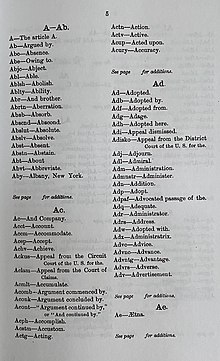
The Phillips Code is a brevity code (shorthand) compiled and expanded in 1879 by Walter P. Phillips (then of the Associated Press) for the rapid transmission of telegraph messages, including press reports.

The Phillips Code is a brevity code (shorthand) compiled and expanded in 1879 by Walter P. Phillips (then of the Associated Press) for the rapid transmission of telegraph messages, including press reports.
It was compiled in 1879 by Walter P. Phillips, who explained that he was in large part putting down the collective experience of generations of telegraph operators. In the introduction to the 1907 edition of his book, "The Phillips Code: A Thoroughly Tested Method of Shorthand Arranged for Telegraphic Purposes. And Contemplating the Rapid Transmission of Press Reports; Also Intended to be Used as an Easily Acquired Method for General Newspaper and Court Reporting," Phillips wrote, "Research suggests that at one time, commercial telegraphs and railroads had numerical codes that contained at least 100 groupings. Few survived beyond the turn of the century. The compilation in this book represents the consensus of many whose duties brought them into close contact with this subject." [1]
His code defined hundreds of abbreviations and initialisms for commonly used words that news authors and copy desk staff would commonly use. There were subcodes for commodities and stocks called the Market Code, a Baseball Supplement, and single-letter codes for Option Months. The last official edition was published in 1925, but there was also a Market supplement last published in 1909 that was separate.
The code consists of a dictionary of common words or phrases and their associated abbreviations. Extremely common terms are represented by a single letter (C: See; Y: Year); those less frequently used gain successively longer abbreviations (Ab: About; Abb: Abbreviate; Abty: Ability; Acmpd: Accompanied).
Later, The Evans Basic English Code [2] expanded the 1,760 abbreviations in the Phillips Code to 3,848 abbreviations.
Using the Phillips Code, this ten-word telegraphic transmission:
ABBG LG WORDS CAN SAVE XB AMTS MON AVOG FAPIB
expands to this:
Abbreviating long words can save exorbitant amounts of money, avoiding filing a petition in bankruptcy.
In 1910, an article explaining the basic structure and purpose of the Phillips Code appeared in various US newspapers and magazines. [3] One example given is:
T tri o HKT ft mu o SW on Ms roof garden, nw in pg, etc.
which the article translates as:
The trial of Harry K. Thaw for the murder of Stanford White on Madison Square Roof Garden, now in progress, etc.
The terms POTUS and SCOTUS originated in telegraph code, and are included in the Phillips code. [4] [5] [6] SCOTUS appeared in the very first edition of 1879 [7] and POTUS was in use by 1895, [4] and was officially included in the 1923 edition. These abbreviations entered common parlance when news gathering services, in particular, the Associated Press, adopted the terminology.
Telegraph operators would often interleave Phillips Code with numeric wire signals that had been developed during the American Civil War era, such as the 92 Code. These codes were used by railroad telegraphers to indicate logistics instructions and they proved to be useful when describing an article's priority or confirming its transmission and receipt. This meta-data would occasionally appear in print when typesetters included the codes in newspapers, [8] [ failed verification ] especially the code for "No more—the end", abbreviated as "- 30 -" on a typewriter.
| Code | Expansion |
|---|---|
| Hag | Haggle |
| Hz | Hazard |
| Igo | In consequence of |
| Kf | Confer |
| Kft | Conflict |
| Kpt | Compete |
| Oac | On account of |
| Ot | Owing to |
| Pcu | Preclude |
| Pkg | Packing |
| Pkj | Package |
| Pmnt | Prominent |
| Px | Price |
| Pxl | Political |
| Rept | Repeat |
| Rlav | Relative |
| Rpv | Representative |
| Sac | Senate Committee |
| Scf | Sacrifice |
| Sovy | Sovereignty |
| Spn | Suspicion |
| Thu | The house |
| Wam | Ways and means |
| _ _ _ _ | Paragraph mark |
| Co | County |
| Dr | Doctor |
| Dx | Dash |
| Ea | Each |
| Ed | Editor |
| Eu | Europe |
| Fm | From |
| Gb | Great Britain |
| Gj | Grand Jury |
| Hc | Habeas corpus |
| Hf | Half |
| Hi | High |
| Kg | King |
| Ld | London |
| Lp | Liverpool |
| Lx | Pounds sterling |
| Mm | Mid-meridian (midnight) |
| Mo | Month |
| Mr | Mister |
| Oc | O'clock |
| Qm | Quartermaster |
| Ry | Railway |
| Sa | Senate |
| Ss | Steamship |
| Td | Treasury Department |
| Xm | Extreme |
| Za | Sea |
| Xg | Legislate |
| Xb | Exorbitant |
| ITC | In this connection |
| IQO | In consequence of |
| IAB | Introduced a bill |
| IAR | Introduced a resolution |
| HVNB | Have not been |
| Hur | House of Representatives |
| GX | Great excitement |
| GOH | Guest of honor |
| IWR | It was reported |
| IXJ | It is alleged |
| KAH | Knots an hour |
| CIC | Commander In Chief |
| UMPS | Umpires |
In communications and information processing, code is a system of rules to convert information—such as a letter, word, sound, image, or gesture—into another form, sometimes shortened or secret, for communication through a communication channel or storage in a storage medium. An early example is an invention of language, which enabled a person, through speech, to communicate what they thought, saw, heard, or felt to others. But speech limits the range of communication to the distance a voice can carry and limits the audience to those present when the speech is uttered. The invention of writing, which converted spoken language into visual symbols, extended the range of communication across space and time.

Electrical telegraphy is a point-to-point text messaging system, primarily used from the 1840s until the late 20th century. It was the first electrical telecommunications system and the most widely used of a number of early messaging systems called telegraphs, that were devised to send text messages more quickly than physically carrying them. Electrical telegraphy can be considered the first example of electrical engineering.

Morse code is a telecommunications method which encodes text characters as standardized sequences of two different signal durations, called dots and dashes, or dits and dahs. Morse code is named after Samuel Morse, one of the early developers of the system adopted for electrical telegraphy.

Telegraphy is the long-distance transmission of messages where the sender uses symbolic codes, known to the recipient, rather than a physical exchange of an object bearing the message. Thus flag semaphore is a method of telegraphy, whereas pigeon post is not. Ancient signalling systems, although sometimes quite extensive and sophisticated as in China, were generally not capable of transmitting arbitrary text messages. Possible messages were fixed and predetermined, so such systems are thus not true telegraphs.
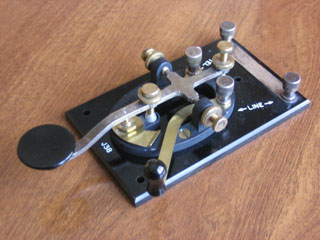
A telegraph key or Morse key is a specialized electrical switch used by a trained operator to transmit text messages in Morse code in a telegraphy system. Keys are used in all forms of electrical telegraph systems, including landline telegraphy and radio telegraphy. An operator uses the telegraph key to send electrical pulses of two different lengths: short pulses, called dots or dits, and longer pulses, called dashes or dahs. These pulses encode the letters and other characters that spell out the message.
A telegraph code is one of the character encodings used to transmit information by telegraphy. Morse code is the best-known such code. Telegraphy usually refers to the electrical telegraph, but telegraph systems using the optical telegraph were in use before that. A code consists of a number of code points, each corresponding to a letter of the alphabet, a numeral, or some other character. In codes intended for machines rather than humans, code points for control characters, such as carriage return, are required to control the operation of the mechanism. Each code point is made up of a number of elements arranged in a unique way for that character. There are usually two types of element, but more element types were employed in some codes not intended for machines. For instance, American Morse code had about five elements, rather than the two of International Morse Code.

Gregg shorthand is a system of shorthand developed by John Robert Gregg in 1888. Distinguished by its phonemic basis, the system prioritizes the sounds of speech over traditional English spelling, enabling rapid writing by employing elliptical figures and lines that bisect them. Gregg shorthand's design facilitates smooth, cursive strokes without the angular outlines characteristic of earlier systems like Duployan shorthand, thereby enhancing writing speed and legibility.
Cadit quaestio is a Latin expression that is used as a legal term and in some other contexts. The expression literally translates as 'the question falls'. In legal contexts, cadit quaestio is used to indicate that an issue is no longer in question, often because a dispute (question) between two parties has been either settled or dropped.

Procedural signs or prosigns are shorthand signals used in Morse code telegraphy, for the purpose of simplifying and standardizing procedural protocols for landline and radio communication. The procedural signs are distinct from conventional Morse code abbreviations, which consist mainly of brevity codes that convey messages to other parties with greater speed and accuracy. However, some codes are used both as prosigns and as single letters or punctuation marks, and for those, the distinction between a prosign and abbreviation is ambiguous, even in context.

Morse code abbreviations are used to speed up Morse communications by foreshortening textual words and phrases. Morse abbreviations are short forms, representing normal textual words and phrases formed from some (fewer) characters taken from the word or phrase being abbreviated. Many are typical English abbreviations, or short acronyms for often-used phrases.
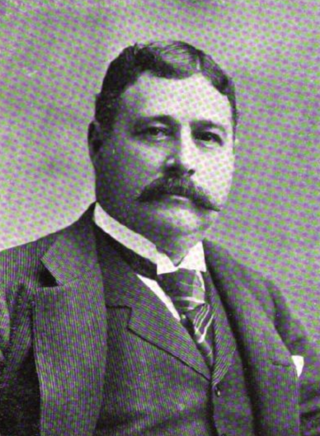
Walter Polk Phillips was an American journalist, telegrapher, and inventor who compiled and expanded telegraph codes with his Phillips Code, a brevity code which included the abbreviations POTUS, for president of the United States, and SCOTUS, for Supreme Court of the United States. He later became the head of the United Press.

Telegram style, telegraph style, telegraphic style, or telegraphese is a clipped way of writing which abbreviates words and packs information into the smallest possible number of words or characters. It originated in the telegraph age when telecommunication consisted only of short messages transmitted by hand over the telegraph wire. The telegraph companies charged for their service by the number of words in a message, with a maximum of 15 characters per word for a plain-language telegram, and 10 per word for one written in code. The style developed to minimize costs but still convey the message clearly and unambiguously.

-30- has been traditionally used by journalists in North America to indicate the end of a story or article that is submitted for editing and typesetting. It is commonly employed when writing on deadline and sending bits of the story at a time, via telegraphy, teletype, electronic transmission, or paper copy, as a necessary way to indicate the end of the article. It is also found at the end of press releases.
A wire signal is a brevity code used by telegraphers to save time and cost when sending long messages. The best-known code was the 92 Code adopted by Western Union in 1859. The code was designed to reduce bandwidth consumption over telegraph lines, thus speeding transmissions by utilizing a numerical code system for frequently used phrases.

The printing telegraph was invented by Royal Earl House in 1846. House's telegraph could transmit around 40 instantly readable words per minute, but was difficult to manufacture in bulk. The printer could copy and print out up to 2,000 words per hour. This invention was first put in operation and exhibited at the Mechanics Institute in New York.
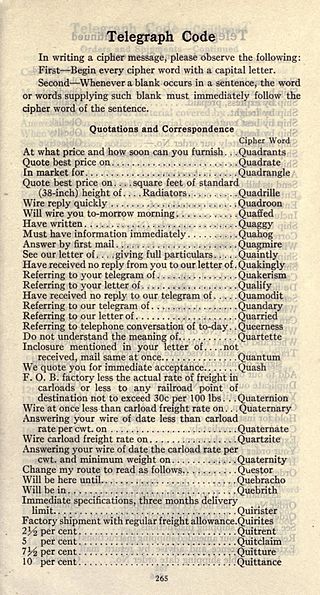
In telecommunication, a commercial code is a code once used to save on cablegram costs. Telegraph charged per word sent, so companies which sent large volumes of telegrams developed codes to save money on tolls. Elaborate commercial codes which encoded complete phrases into single words were developed and published as codebooks of thousands of phrases and sentences with corresponding codewords. Commercial codes were not generally intended to keep telegrams private, as codes were widely published; they were usually cost-saving measures only.
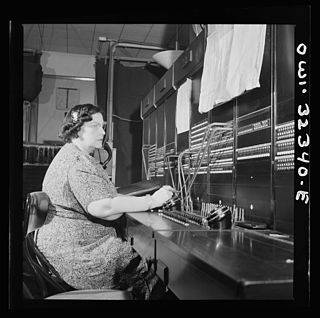
Women in telegraphy have been evident since the 1840s. The introduction of practical systems of telegraphy in the 1840s led to the creation of a new occupational category, the telegrapher, telegraphist or telegraph operator. Duties of the telegrapher included sending and receiving telegraphic messages, known as telegrams, using a variety of signaling systems, and routing of trains for the railroads. While telegraphy is often viewed as a males-only occupation, women were also employed as telegraph operators from its earliest days. Telegraphy was one of the first communications technology occupations open to women.
Australian railway telegraphic codes were devised to reduce the size of telegraphic messages, though some survived into the telephone era. They were used in telegrams between various parts of the railway system, such as offices, stations, locomotive depots and goods yards.
Brevity codes are used in amateur radio, maritime, aviation and military communications. They are designed to convey complex information with a few words or codes. Some are classified from the public.
{{cite news}}: CS1 maint: postscript (link)